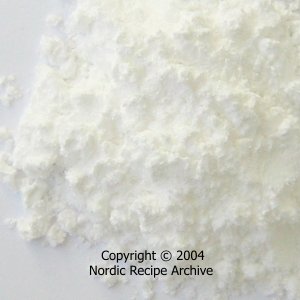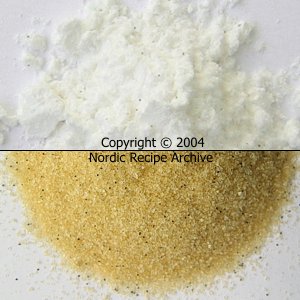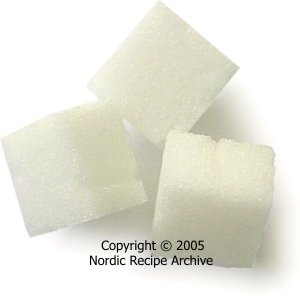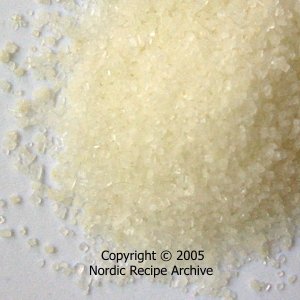|
|
|
SUGARS
|
Listed below are some sugar types used in Finnish cooking and in the recipes of this site.
Read more about various sugar syrups, molasses and honey here.
See also:
|
|
WHITE SUGARS
White sugar is made by refining raw sugar obtained from sugar cane or sugar beet, removing all impurities.
|

Caster sugar

Caster sugar is white, granulated sugar with very fine sugar crystals. It is also called superfine sugar, ultra fine sugar or bar sugar.
It is best used in baking and desserts, in making of cakes, mousses and drinks, as well as
in foods and pastries that are sprinkled, rolled or coated with sugar.
In making jams, marmalades, preserves etc, superfine sugar can be replaced with coarser granulated sugar (see right).
|

|

Granulated sugar

Regular granulated sugar has coarser crystals than caster or superfine sugar. It may be used in making preserves, jams, marmalades and sugar syrups.
In dishes where sugar is to be whipped with eggs, cream etc, it is best to use superfine sugar (see left).
|
|
|
Icing sugar

Icing sugar, also known as confectioners' sugar, is made of white sugar ground into a smooth, white powder and used in icings, confections, drinks etc.
There is usually an amount of starch mixed in icing sugar to prevent clumping. Also differently coloured or flavoured icing sugars can be found on sale.
|
Decorating sugar

This white, large crystal sugar is unevenly shaped and used to sprinkle on top of sweet buns and other baked goods
for garnish. It may also be called pearl, sanding, coarse or crystal sugar.
There are also coloured decorating sugars on sale.
|
|
|
Vanilla sugar

A rather good substitute for real vanilla, vanilla sugar is powdered or granulated white sugar flavoured with real vanilla bean. Depending on the brand, the colour and texture of vanilla sugars may vary from white to brownish and granular to powdered. Usually there are tiny black dots of powdered vanilla bean or seeds visible in the sugar.
Vanilla sugar is used instead of vanilla bean to give vanilla flavour to various sweet baked goods, desserts, whipped cream and beverages. It is added to foods only in small amount (usually 1 - 2 teaspoons per a batch of batter, dough, etc). Vanilla sugar can be replaced with the same or slightly smaller amount of good-quality vanillin sugar, see right.
Best varieties of vanilla sugar should have a strong but pleasant, not bitter, taste of vanilla. Of the most widely available vanilla sugar products in Finland, the best brand to be used in the recipes of this site is the one produced by the coffee and spice producer company Meira Oy (pictured in the lower part of the photo above).
Another variety is the vanilla sugar produced by Dannsukker (pictured in the upper part of the photo above), but this has a distinctively strong lemony off-taste, which would be too overpowering in certain more delicate dishes (vanilla custards, whipped cream, paskha, etc).
One of the worst brands of vanilla sugar available in Finland is produced by Dr. Oetker — like all their other products, their vanilla sugar is of an exceptionally bad quality and should never be used.
Vanilla sugar may also be made at home by steeping a whole vanilla bean in a jar of granulated, superfine sugar for about two weeks, or by whizzing dried vanilla beans with granulated sugar in a food mixer or blender.
However, the flavour of homemade vanilla sugar is usually less intense than that of the commercial brands, which should be noted if substituting commercial sugar with homemade sugar.
|
Vanillin sugar

Vanillin sugar consists of finely granulated sugar flavoured with synthetic vanillin.
Vanillin is a compound responsible for the characteristic flavour of vanilla. Besides vanilla beans, natural vanillin occurs widely in the nature in other plants and essential oils, and it is also produced synthetically.
One source of synthetic vanillin is lignin, a substance
found in trees, separated from the wood tissue by chemical pulping process.
Vanillin sugar is slightly bitter in taste. It is added to foods only in small amount (usually 1 - 2 teaspoons per a batch of batter, dough, etc). It should be added to custards and sauces that are cooked on stovetop no sooner than just after cooking, as boiling usually turns it bitterer.
Most Finnish brands of vanillin sugar are not too bad in substituting real vanilla. Vanillin sugar can be replaced with the same or slightly larger amount of good-quality vanilla sugar, see left.
|

|
|
See more information about vanilla.
|
|
|
Cube sugar
|

White sugar cubes
|

Brown sugar cubes
|

|
|
Also called lump sugar, sugar cubes are made by moulding and drying moistened, hot granulated sugar. Coming in various forms and colours, lump sugar is mainly used to sweeten various hot drinks.
In cooking, lump sugar and sugar cubes may be used instead of granulated sugar in recipes where sugar is melted, like syrups and caramel. Sugar cubes are also used in desserts like crêpes Suzette, where they are rubbed against the zest of citrus fruit to absorb their essential oils, in order to flavour the dish.
Lump sugar can be ground into granules or powdered using a mortar, a blender or a food processor.
|
|
|
Jam sugar

Jam sugar is a special gelling sugar used in making jams, marmalades, jellies and other preserves, instead of regular white sugar. It consists of white, granulated sugar (about 98 %) added with natural fruit pectin (E440, gelling agent), citric acid (E330, antioxidant) and potassium sorbate (E202, preservative).
When using jam sugar, the cooking time of various preserves is often reduced, thus better maintaining the flavours, colours and vitamins of the fruits and berries used. To determine how much jam sugar to use in proportion to fruits or berries, follow the instructions on the sugar package.
Jam sugar cannot be used instead of regular sugar in baking or cooking, but only in making of jams, marmalades and fruit compotes or soups.
|
Jelly sugar

Jelly sugar is used to decorate desserts and pastries and to make set, clear dessert jellies. Jelly made with jelly sugar is spooned or brushed over berry and fruit garnishes to give them a thin and shiny, protective jelly coating. Jelly sugar is not suitable to be used in milk-based jellies and puddings or in canning and preserving.
Jelly sugar consists of white, granulated sugar, glucose syrup, natural fruit pectin (E440, gelling agent) and citric acid (E330, antioxidant). The sugar is mixed in boiling water and left to cool for a couple of minutes before spreading or pouring on the food.
To determine how much jelly sugar to use in proportion to water or in making of jellied berry or fruit desserts, follow the instructions on the sugar package.
|
|
|
BROWN SUGARS
Traditional, natural brown sugars are made of partially refined raw cane sugar, containing certain impurities, which give them their brown colour.
Depending on the sugar type, the colour ranges from very dark to pale brown, and the taste from a strong, almost liquorice-like to a lighter molasses flavour.
These types of brown sugars include the demerara and muscovado sugars.
Today, commercially produced brown sugars are mostly made by coating granulated, refined white sugar with a thin layer of dark molasses, giving them a brown colour with molasses flavour.
|
|
Granulated brown sugar

Regular granulated brown sugar is made by coating white sugar with a layer of dark molasses. It has loose, non-sticky sugar crystals with the colour ranging from light to dark brown.
This type of brown sugar has a light, clean molasses flavour and a coarser texture than white, superfine sugar.
Granulated brown sugar can be replaced for example with demerara sugar (see below).
|
Soft brown sugar

Soft brown sugar is made by coating white sugar with a layer of dark molasses. It is firmly packed, moist and slightly sticky, and has a stronger molasses flavour
than brown, loose sugar (see left).
Soft brown sugar should be stored wrapped airtight to prevent it from drying and hardening into a clump. Hardened sugar will soften in a couple of days, when you add a few drops of water in the sugar package and close it tightly.
Soft brown sugar can be replaced for example with light muscovado sugar (see below).
|
|
|
Demerara sugar

Named after the Demerara area of Guyana, the coarse-grained demerara sugar is brown, partially refined raw sugar containing some residual impurities.
The colour of demerara sugar varies from golden brown (eg turbinado sugar) to dark brown, with a strong dark molasses flavour.
Demerara sugar can be used to sweeten and flavour various hot beverages, and it is used in fruit and berry desserts or in making candies and toffees.
Depending on its colour, texture and depth of flavour, it can be used to replace granulated or soft brown sugar in many sweet and savoury dishes.
Turbinado sugar is a further refined type of demerara sugar with a pale colour and a mild flavour.
|
Muscovado sugar

Muscovado sugar is the darkest of the partially refined brown raw sugars. It has slightly sticky crystals, with the colour varying from light to dark brown.
Muscovado sugar can be used to flavour tea, coffee and other beverages. It brings deep and dusky flavour of molasses into various dishes and desserts. Light muscovado sugar can be used to replace soft brown sugar in cooking and baking.
Barbados sugar is a type of muscovado sugar with a finer texture.
|
|
|

